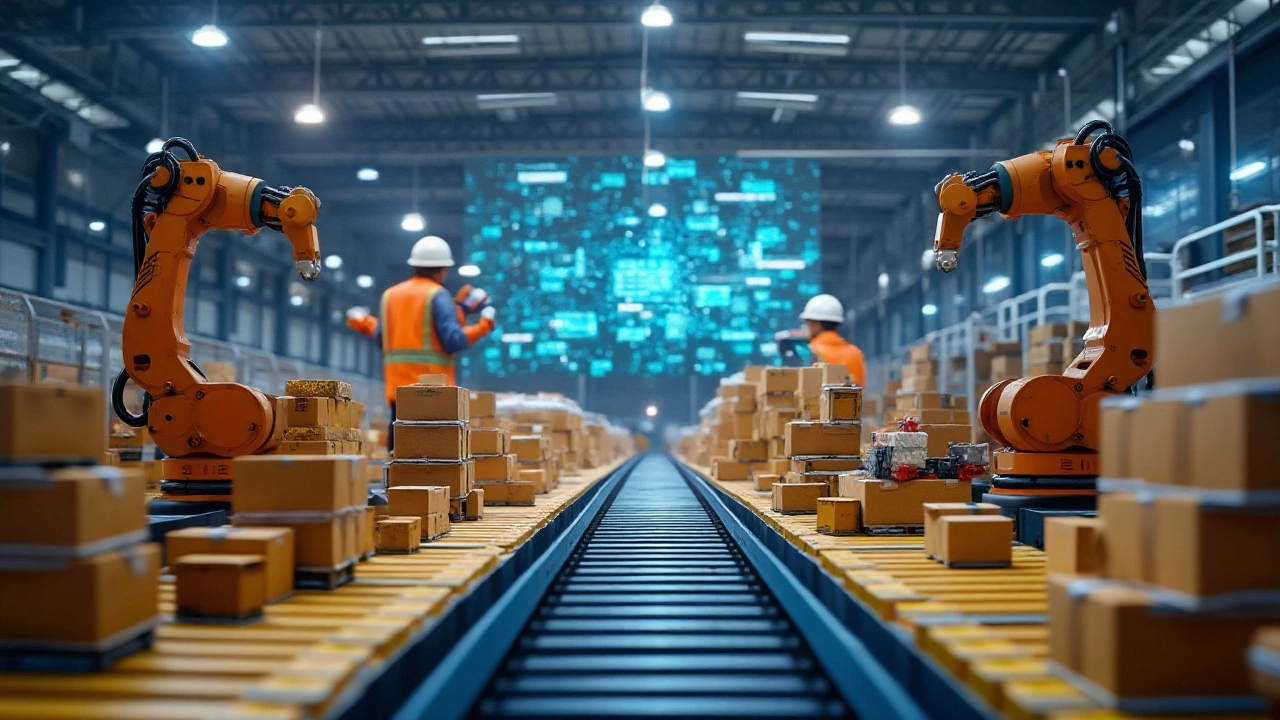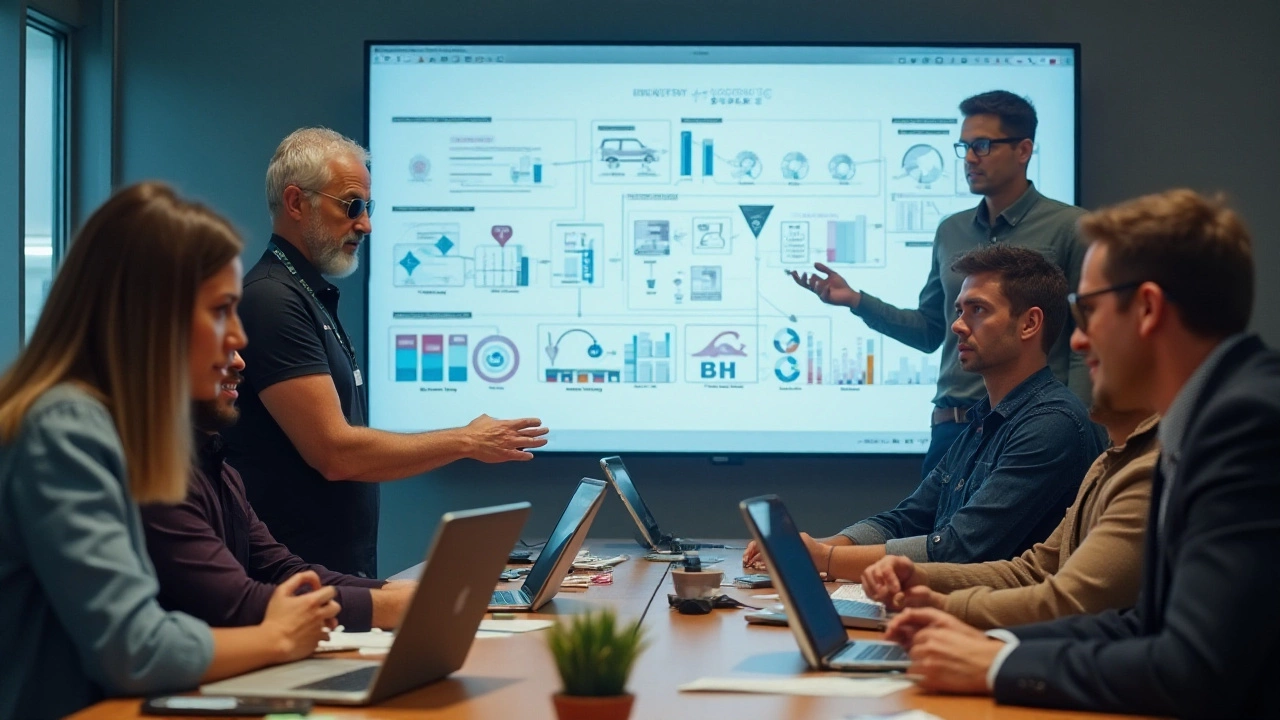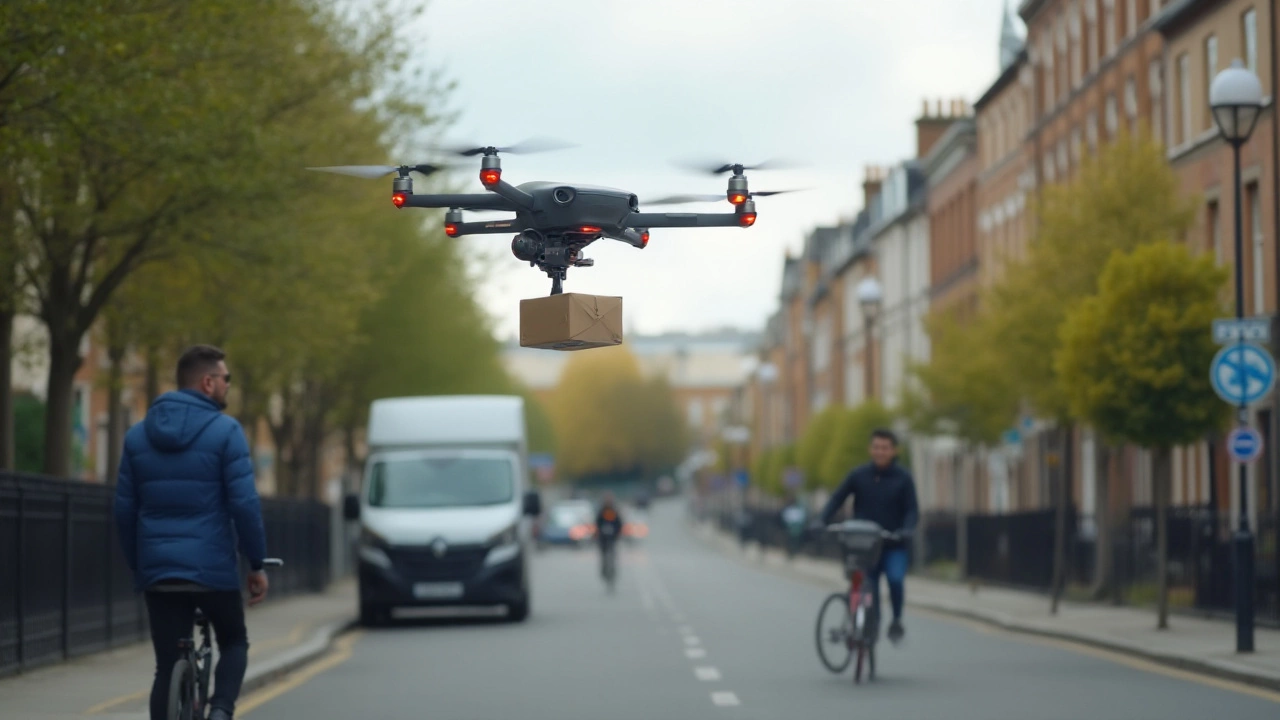Understanding E-Logistics in E-Commerce: Seamless Integration Explained

In the bustling world of e-commerce, logistics often works silently behind the scenes, yet it’s the backbone that keeps everything running smoothly. E-logistics isn’t just about moving packages from point A to B; it’s a sophisticated system that ensures products are available to be shipped as soon as customers place an order. From warehouse management to real-time delivery tracking, e-logistics covers all these crucial aspects.
At its core, e-logistics is about optimizing the supply chain to enhance efficiency and customer satisfaction. The goal is to make the journey from purchase to delivery as seamless as possible. By harnessing the power of digital tools, businesses can anticipate demands, manage inventory better, and offer quicker delivery options than ever before. Today, let's explore how e-logistics makes this possible and why it's vital for any successful e-commerce operation.
- What is E-Logistics?
- Key Components of E-Logistics
- The Role of Technology in E-Logistics
- Benefits and Challenges
- Future Trends in E-Logistics
What is E-Logistics?
E-logistics is a pivotal component in the realm of e-commerce, acting as the digital transformation of traditional logistics processes. It's a seamless integration of technology and logistics that allows for the efficient management of the supply chain, from order placement to the final delivery at your doorstep. This complex system leverages digital tools to automate and optimize the flow of information and goods, making it possible for businesses to meet the ever-growing demands of online shoppers. As shopping online becomes second nature to consumers, the need for a well-oiled e-logistics machine becomes more apparent. Every click on the 'buy' button initiates a series of technological maneuvers in this digital symphony of e-logistics.
To understand e-logistics better, picture it as a vast network connecting different aspects of the supply chain. This includes inventory management, order processing, warehousing, transportation, and real-time tracking systems. These components are interconnected through advanced software solutions, allowing for improved speed and accuracy in inventory updates. Such systems ensure that warehouses are never over or under-stocked, reducing wait times for the e-commerce customer and enhancing satisfaction. By assigning unique identifiers to each product, items are tracked accurately across the system, ensuring nothing gets lost along the way. Such precision is vital in today's competitive online market, where customer loyalty can pivot on the speed and condition of delivery.
The Tools Behind E-Logistics
One cannot overlook the importance of technology in e-logistics. Modern businesses use a combination of enterprise resource planning (ERP) systems, warehouse management systems (WMS), and transport management systems (TMS) to streamline operations. These tools are crucial for coordinating logistics activities efficiently and providing intuitive interfaces for tracking shipments in real time. They empower businesses to make data-driven decisions that enhance both speed and accuracy. Through the power of cloud computing, these systems can be accessed remotely, enabling real-time updates and adjustments as required. Strategically employing technology in such a way grants e-commerce platforms agility and responsiveness previously unattainable in traditional logistics.
"Businesses that embrace e-logistics not only meet customer expectations but exceed them, thus fostering brand loyalty in an ever-evolving digital landscape." — Dr. Amelia Knox, Logistics Analyst
The sophistication of e-logistics also lies in its ability to adapt to the specific needs of different industries. For example, perishable goods might require refrigerated transportation, while electronic gadgets often need secure electronic tracking due to their high value. By tailoring logistics solutions to product-specific needs, e-logistics minimizes risk and enhances delivery integrity, increasing customer trust. Efficient e-logistics networks play a crucial role in handling returns—a significant aspect of the e-commerce experience that can greatly influence a customer's overall perception of service quality.
As we look into the future, e-logistics will likely continue to evolve alongside technological advancements. Artificial intelligence and machine learning are already beginning to play a role in predicting consumer behavior, managing routes for delivery vehicles, and identifying inefficiencies in the logistics chain. This evolution points towards a more synchronized and sustainable approach to logistics, offering opportunities to both reduce costs for businesses and improve the customer experience. The impact of these technologies will be profound, establishing a new norm in the way we understand and implement logistics in the digital age.
Key Components of E-Logistics
At the heart of e-logistics lies a set of vital components that intertwine like the gears of a well-oiled machine, facilitating seamless operations in the world of e-commerce. Each component works in unison to ensure that everything from order processing to final mile delivery operates without a hitch. To kick things off, inventory management must be put in the spotlight. The essence of successful e-logistics begins with efficient inventory tracking, which helps businesses maintain the right amount of stock, minimizing both shortages and overstock scenarios. Employing sophisticated software in tracking the availability and demand projections allows retailers to pivot quickly to market fluctuations.
Another indispensable component is the warehousing and picking operations. Warehouses are no longer simple storage areas; they have transformed into hubs geared with advanced technology. Automation has stepped into center stage, with robots and conveyor systems enhancing the speed and accuracy of picking processes. In addition to technological investments, these warehouses must be strategically located to reduce delivery times. Next is the real-time tracking and shipping management systems. These ensure customers can monitor their orders, providing transparency and increased confidence in the purchase process. Systems such as GPS and RFID are employed to keep both businesses and customers informed about shipment status every step of the way.
"Efficiency and accuracy in the logistics process are key to success in e-commerce," states logistics expert Sarah Harrison.
We mustn't forget the indispensable role of a robust payment and returns management system. Seamless payment processes are crucial to maintaining customer satisfaction, and an efficient returns process is essential for retaining loyalty. Allowing customers an easy way to return products and receive refunds keeps trust levels high and feedback positive. Last but definitely not least is the strategic integration of technology platforms, like Cloud Computing and Artificial Intelligence, which are used extensively to analyze data, predict consumer behavior, and improve logistics operations. These technology platforms effectively remove much of the guesswork from the logistics process and allow for data-driven decisions that enhance efficiency and profitability.
A less discussed yet equally critical component is the human factor—skilled professionals who manage and optimize these complex systems. While technology plays a significant role, the insights and adaptability of logistics managers ensure these e-logistics systems react dynamically to challenges. As we dive deeper into e-logistics, we embrace a world where technology meets human ingenuity, propelling supply chain management to new heights.

The Role of Technology in E-Logistics
E-logistics might sound like just another buzzword, but it’s rooted in very real, tangible solutions that transform the way e-commerce operates. The integration of technology into logistics isn't futuristic anymore; it's happening right now. One of the most pivotal elements here is the fusion of data analytics with logistics processes, ensuring that businesses can predict buying trends and optimize their stock levels accordingly. This not only reduces the risk of understocking or overstocking but also aligns inventory with real-time demand.
Warehouse automation is another cog in the e-logistics machine that cannot be overlooked. Utilizing robotics and AI, businesses can ensure faster and more accurate picking, packing, and sorting of items. This translates into significantly reduced human error and speedier delivery times, meeting the ever-increasing customer expectations for quicker product arrival. Moreover, automated systems are now adept at handling a dizzying variety of products, from electronics to perishables, without breaking a sweat.
Real-Time Tracking and Transparency
Real-time tracking technologies, powered by GPS and RFID, allow customers to follow their package’s journey from the warehouse to their doorstep. It’s transparency like never before, instilling confidence and reliability in the e-commerce process. A study by MetaPack revealed that 96% of consumers would shop again with a retailer if they had a positive delivery experience. This statistic underscores the critical role that tracking technology plays in achieving customer satisfaction.Technology doesn’t just end at customer satisfaction; it extends inward, enhancing operational efficiency. Cloud-based logistics management systems enable companies to consolidate their operations across different regions into one cohesive unit. These platforms help in managing everything from order processing to shipment and deliver analytical insights that inform strategic decisions. When issues arise, they’re identified quickly, preventing minor hiccups from turning into major setbacks.
The future of logistics is digital. Even traditional logistics providers are transitioning to tech-centric solutions to remain competitive in this rapidly changing landscape. - Logistics Bureau
Advanced Delivery Methods
Finally, let's not ignore the fascinating strides being made in delivery technologies. Drones and autonomous vehicles are gradually moving from experimental phases into real-world applications. These advancements promise not only faster delivery times but also reduced costs and environmental impact. For instance, a study by McKinsey predicts that robot deliveries could lead to a 40% reduction in urban shipping costs. It's innovations like these that are crafting the e-logistics landscape, pushing the boundaries of what’s possible.In sum, technology in e-logistics is a multifaceted powerhouse driving the future of e-commerce. It's an exciting time, with developments that promise to enhance efficiency, reduce costs, and ultimately, make shopping a more delightful experience for consumers. As more businesses adapt these technologies, we're bound to witness a more interconnected and responsive supply chain ecosystem.
Benefits and Challenges
E-logistics in e-commerce comes with a host of benefits that are vital for businesses striving to meet the growing demands of online shoppers. One key advantage is improved efficiency. By integrating logistics solutions with digital systems, companies can streamline their operations, facilitating quicker order processing, better inventory control, and faster delivery times. This integration also helps reduce errors, such as shipping incorrect items or misplacing parcels, which can dent customer satisfaction. Additionally, e-logistics enables businesses to reach wider markets beyond geographical boundaries, offering opportunities for global expansion that traditional brick-and-mortar stores might not have.
However, such advancements come with their fair share of challenges. Setting up a seamless e-logistics system requires a significant investment in technology and infrastructure, which can be daunting for smaller businesses. Data management is another critical aspect, as companies must efficiently handle the vast amount of information generated daily, ensuring data security and privacy. As the volume of sales increases, so does the complexity of logistics management, often resulting in bottlenecks without the right strategy. According to a 2023 report by the National Retail Federation, "The success of an e-commerce business today hinges on its logistics performance. A reliable, scalable system is essential."
Additionally, logistics operations must be adaptable to the ever-changing e-commerce landscape, including fluctuations in demand during peak seasons like Black Friday or unexpected disruptions, such as supply chain issues caused by global events. Businesses must also contend with energy consumption and environmental concerns in their logistics operations. An increasing number of consumers are aware of their carbon footprint, nudging companies to adopt more sustainable practices, such as using eco-friendly packaging and optimizing delivery routes to reduce emissions.
Balancing Benefits with Practical Challenges
Navigating these challenges requires strategic planning and continual adaptation. Companies can mitigate some of these issues by leveraging advanced analytics to forecast demand more accurately, enabling better inventory management and reducing waste. Collaborations with logistics partners that possess a widespread shipping network can also reduce the costs of establishing such a network independently. Furthermore, adopting cloud-based solutions can mitigate data management challenges by ensuring real-time data access and collaboration among different departments. To address environmental concerns, investing in electric delivery vehicles and setting measurable sustainability goals could meet consumer expectations for greener supply chains.
Despite challenges, the competitive edge provided by a well-tuned logistics system is undeniable. It enhances customer experience by providing transparency and reliability in the delivery process. A survey by McKinsey highlighted that companies with robust e-logistics frameworks reported a 70% increase in customer retention and a 50% boost in productivity. These figures illustrate the tangible benefits that outweigh initial setup hurdles, driving home the importance of investing in strong logistics infrastructure for future growth.

Future Trends in E-Logistics
The landscape of e-logistics is poised for significant transformation in the coming years. One of the most impactful trends is the integration of artificial intelligence in managing supply chains. AI is set to revolutionize inventory management, enabling businesses to predict demand with unprecedented accuracy. This shift not only boosts efficiency but also minimizes waste by aligning stock levels with customer purchases dynamically. The days of guesswork in logistics are numbered as data-driven strategies take the forefront.
Another notable trend on the horizon is the increasing importance of last-mile delivery solutions. With customers demanding faster delivery times, companies are investing in innovative methods to expedite this crucial part of the shipping process. Drones and autonomous vehicles are beginning to make their mark, promising to cut down delivery times significantly while reducing costs. Companies like Amazon have already begun experimenting with drone deliveries, hinting at a future where these intelligent machines might become commonplace.
"The adoption of AI in logistics can save the industry billions annually," - Logistics Management Journal
As sustainability becomes a key concern across all industries, e-logistics is no exception. Green logistics is gaining traction, with companies exploring electric vehicles and eco-friendly packaging solutions to minimize their carbon footprint. Businesses are increasingly being held accountable for their environmental impact, leading to a surge in sustainable practices. This shift is about more than just compliance; it's about meeting the expectations of a more environmentally conscious customer base.
Blockchain technology is also set to reshape e-logistics by enhancing transparency and traceability within supply chains. By providing an immutable record of transactions, blockchain ensures that every step from production to delivery is documented and verifiable. This development promises to build trust between businesses and customers, as well as streamline cross-border transactions by reducing bureaucracy and paperwork.
| Technology | Impact |
|---|---|
| AI | Demand prediction and inventory optimization |
| Drones | Faster last-mile delivery |
| Blockchain | Enhanced transparency and reduced bureaucracy |
Finally, the rise of personalization in e-commerce is influencing logistics strategies. Customized delivery options are becoming a selling point, with companies offering tailored shipping experiences to meet individual customer preferences. Whether it's choosing specific delivery windows or selecting pick-up points, personalization reflects a shift towards a more customer-centric e-logistics approach. As technology continues to evolve, staying ahead of these trends will be crucial for businesses aiming to maintain a competitive edge in this rapidly progressing field.